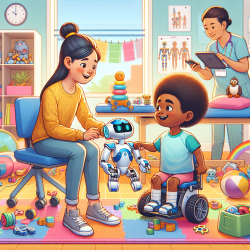As practitioners in the field of pediatric rehabilitation, leveraging innovative technologies can significantly enhance the outcomes for our young patients. One such promising innovation is Lil’Flo, a socially assistive robot designed for upper extremity motor assessment and rehabilitation via telepresence. The research paper titled The design of Lil’Flo, a socially assistive robot for upper extremity motor assessment and rehabilitation in the community via telepresence provides comprehensive insights into the development and efficacy of this technology.
Here, we will discuss how practitioners can implement the outcomes of this research to improve their skills and encourage further research in this field.
Understanding Lil’Flo
Lil’Flo combines traditional telepresence and computer vision with a humanoid robot, creating a more engaging and interactive experience for pediatric patients with cerebral palsy and brachial plexus injuries. The system is designed to play games and guide patients under the supervision of a remote clinician, making it particularly useful in rural and elder care facilities where access to rehabilitation professionals is limited.
Key Features and Benefits
- Portability: Lil’Flo is more portable and extensible than previous iterations, making it easier to deploy in various settings.
- Engagement: The humanoid robot’s expressive features and interactive capabilities can enhance patient motivation and compliance.
- Cost-Effectiveness: The system is designed to be more affordable, allowing broader implementation.
Practical Implementation Tips
To effectively integrate Lil’Flo into your practice, consider the following steps:
- Training: Ensure that clinicians and support staff are well-trained in operating and maintaining the Lil’Flo system.
- Patient Engagement: Utilize the robot’s interactive games to keep patients engaged and motivated during their rehabilitation sessions.
- Remote Monitoring: Leverage the telepresence capabilities to conduct regular assessments and provide timely interventions.
Encouraging Further Research
The research on Lil’Flo opens several avenues for further exploration. Practitioners are encouraged to participate in pilot studies and provide feedback on the system’s performance. Additionally, investigating the long-term impact of Lil’Flo on patient outcomes can provide valuable data to refine and improve the technology.
By adopting innovative solutions like Lil’Flo, we can enhance the quality of care for pediatric patients and overcome the challenges posed by limited access to rehabilitation professionals.
To read the original research paper, please follow this link: The design of Lil’Flo, a socially assistive robot for upper extremity motor assessment and rehabilitation in the community via telepresence.










